Do you have a question about the NTI Trinity TX Series and is the answer not in the manual?
Explains the meaning of hazard symbols (Danger, Warning, Caution, Notice).
Outlines requirements for installing NTI Trinity Tx gas boilers.
Defines the homeowner's role in boiler maintenance and service.
Outlines the installer's duties regarding installation and informing the owner.
Details technical specifications for various Trinity Tx models.
Explains how to de-rate boiler capacity for installations above 2000 ft.
Specifies required clearances around the boiler for safe operation and maintenance.
Provides steps for safely removing an old boiler from a shared venting system.
Discusses best practices for direct vent boiler installations.
Details essential steps before starting up boilers with plastic venting.
Lists approved materials for vent and air-inlet piping systems.
Overview of direct vent termination options.
Illustrates various sidewall termination configurations.
Illustrates various roof termination configurations.
Detailed illustrations of sidewall termination setups.
Detailed illustrations of roof termination setups.
General rules and guidelines for boiler venting installation.
A quick reference table for vent and air-inlet termination clearances.
Step-by-step guide for installing the condensate trap.
Lists conversion kits and orifice numbers for propane use.
Procedures for the first time the boiler is started.
Instructions for relighting the boiler if it goes out.
Steps for calibrating burner combustion using a analyzer.
How to adjust the throttle screw for CO2 calibration.
How to adjust the offset screw for CO2 calibration.
Steps to prepare the system for boiler connection, including flushing.
Parameters for heating system water quality.
Describes the installation of pressure relief valve, gauge, and LWCO.
Lists minimum water flow rates required for each boiler model.
Information on the boiler's circulating pumps and their sizing.
Examples of primary/secondary loop configurations for various systems.
Guidelines for promoting air removal from the system.
Guidance on sizing and locating the expansion tank.
Explains the Preheat Mode feature for improved DHW comfort.
Details the DHW inlet/outlet connections and plumbing.
Explains how and where wiring connections are made.
Lists terminal connections and their descriptions for field wiring.
Information on the maximum load rating for circulator outputs.
Instructions for wiring communication between boilers in a cascade.
Guidance on installing boilers in parallel primary/secondary plumbing.
A detailed wiring diagram for boiler connections.
A ladder-logic diagram illustrating boiler wiring.
Comprehensive checklists for installation, start-up, operation, and final checks.
A checklist for annual boiler inspections.
Steps for cleaning the combustion chamber.
Safety precautions and PPE for handling refractory ceramic fibers.
Describes the boiler's behavior upon initial power application.
Explains the information displayed on the main screen.
How to access and navigate the user menu for viewing information.
How to access and adjust installer settings.
How to view lockout and error history logs.
Explains how lockouts are indicated and cleared.
Explains how blocking errors are indicated and cleared.
Explains the "FILL" indicator for low water pressure.
Steps to diagnose why the boiler is not operating.
Troubleshooting steps for no heat to radiators.
Troubleshooting steps for no domestic hot water.
Troubleshooting steps for insufficient DHW temperature.
Exploded view of heat exchanger, piping, and gas train components.
A comprehensive list of all parts for the Tx series boilers.
Explains the meaning of hazard symbols (Danger, Warning, Caution, Notice).
Outlines requirements for installing NTI Trinity Tx gas boilers.
Defines the homeowner's role in boiler maintenance and service.
Outlines the installer's duties regarding installation and informing the owner.
Details technical specifications for various Trinity Tx models.
Explains how to de-rate boiler capacity for installations above 2000 ft.
Specifies required clearances around the boiler for safe operation and maintenance.
Provides steps for safely removing an old boiler from a shared venting system.
Discusses best practices for direct vent boiler installations.
Details essential steps before starting up boilers with plastic venting.
Lists approved materials for vent and air-inlet piping systems.
Overview of direct vent termination options.
Illustrates various sidewall termination configurations.
Illustrates various roof termination configurations.
Detailed illustrations of sidewall termination setups.
Detailed illustrations of roof termination setups.
General rules and guidelines for boiler venting installation.
A quick reference table for vent and air-inlet termination clearances.
Step-by-step guide for installing the condensate trap.
Lists conversion kits and orifice numbers for propane use.
Procedures for the first time the boiler is started.
Instructions for relighting the boiler if it goes out.
Steps for calibrating burner combustion using a analyzer.
How to adjust the throttle screw for CO2 calibration.
How to adjust the offset screw for CO2 calibration.
Steps to prepare the system for boiler connection, including flushing.
Parameters for heating system water quality.
Describes the installation of pressure relief valve, gauge, and LWCO.
Lists minimum water flow rates required for each boiler model.
Information on the boiler's circulating pumps and their sizing.
Examples of primary/secondary loop configurations for various systems.
Guidelines for promoting air removal from the system.
Guidance on sizing and locating the expansion tank.
Explains the Preheat Mode feature for improved DHW comfort.
Details the DHW inlet/outlet connections and plumbing.
Explains how and where wiring connections are made.
Lists terminal connections and their descriptions for field wiring.
Information on the maximum load rating for circulator outputs.
Instructions for wiring communication between boilers in a cascade.
Guidance on installing boilers in parallel primary/secondary plumbing.
A detailed wiring diagram for boiler connections.
A ladder-logic diagram illustrating boiler wiring.
Comprehensive checklists for installation, start-up, operation, and final checks.
A checklist for annual boiler inspections.
Steps for cleaning the combustion chamber.
Safety precautions and PPE for handling refractory ceramic fibers.
Describes the boiler's behavior upon initial power application.
Explains the information displayed on the main screen.
How to access and navigate the user menu for viewing information.
How to access and adjust installer settings.
How to view lockout and error history logs.
Explains how lockouts are indicated and cleared.
Explains how blocking errors are indicated and cleared.
Explains the "FILL" indicator for low water pressure.
Steps to diagnose why the boiler is not operating.
Troubleshooting steps for no heat to radiators.
Troubleshooting steps for no domestic hot water.
Troubleshooting steps for insufficient DHW temperature.
Exploded view of heat exchanger, piping, and gas train components.
A comprehensive list of all parts for the Tx series boilers.
| Category | Boiler |
|---|---|
| Brand | NTI |
| Series | Trinity TX |
| Fuel Type | Natural Gas or Propane |
| Configuration | Wall-Mounted |
| Efficiency | Up to 95% AFUE |
| Heat Exchanger Material | Stainless Steel |
| Ignition Type | Electronic Ignition |
| Venting | Direct Vent |
| Weight | Varies by model |
| Warranty | 10 years heat exchanger |
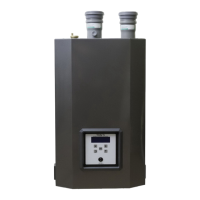
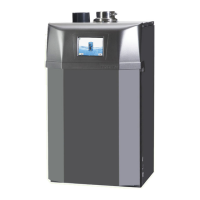
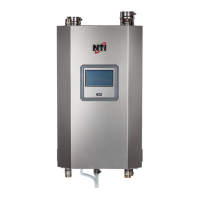
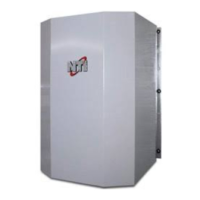
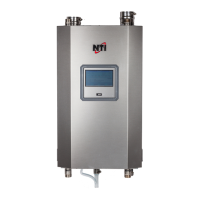
